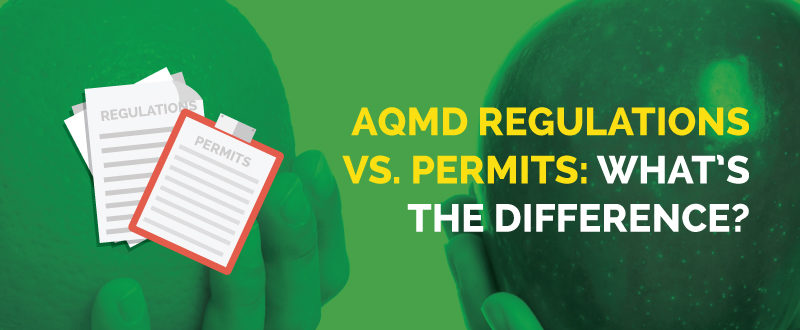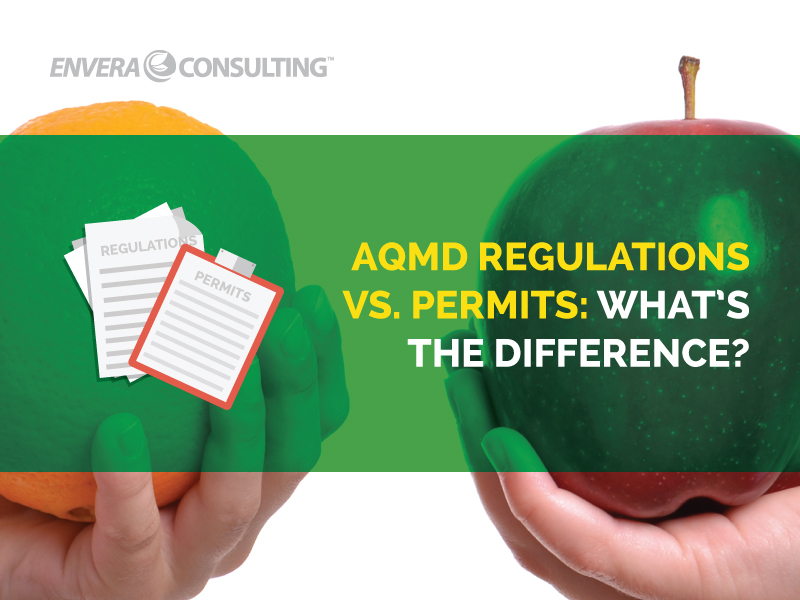

In helping clients understand SCAQMD requirements, we at Envera have often seen folks get mixed up with permits and regulations. And we can see why — there’s a lot of overlap.
For those short on time, here’s a quick breakdown: Regulations are broad-reaching requirements that are always in effect and, therefore, must always be followed, regardless of whether a permit is required. Permits, on the other hand, are only required in certain circumstances and are generally much narrowly focused than regulations.
If you’ve got some time and need more info, here’s a deeper breakdown, as well as examples of each.
Regulations
Generally speaking, regulations cover operational and performance standards that must be followed or adhered to by facilities. These standards are quite detailed and are designed to place limitations or restrictions on how covered processes (e.g., solvent-cleaning operations) or types of equipment (e.g., commercial baking equipment) can be operated.
Regulations cover all classes of equipment, permitted and otherwise, within the SCAQMD’s jurisdiction and can also cover manufacturers of products such as solvents and paints. Requirements can include anything from monitoring and reporting to recordkeeping.
Regulations always need to be followed, regardless of whether permitting is required.
Of course, when we say “always,” there are exceptions. There are cases when a regulation does not need to be followed if permitting is not needed. For example, Rule 1147 only needs to be followed if a permit is required. A similar situation exists for Rule 1110.2, so it’s important to bone up on both of those rules to determine whether or not you need to comply.
Example: Rule 1171
Rule 1171 applies to all solvent-cleaning operations that are present at facilities within the SCAQMD. On a high level, Rule 1171 sets limits on the volatile organic compound (VOC) content of the solvents used during various cleaning activities.
So if you have a facility that uses a cleaning solvent, you need to understand and comply with Rule 1171 — even if your facility isn’t required to hold a permit for that process. For example, the solvents used for surface preparation at a medical-device operation cannot exceed a VOC limit of 800 g/L. The rule also has other requirements, such as recordkeeping.
Permits
Simply put, permits are a mechanism that consolidates all regulations that pertain to a single piece of equipment. At least, that’s what permits do in theory. (More on that in a second.) Permits aren’t necessarily stricter than regulations, but they are more specific, covering a specific piece of equipment or process at a single location.
The goal of permitting is to ensure that the permitted equipment can comply with all applicable rules and regulations. However, unlike a regulation, permits are only needed sometimes.
When we first take on a client at Envera, we start with the assumption that every piece of the client’s equipment needs a permit. Then we refer to the “trio of permit-applicability rules” — Rules 201, 219, and 222 — to see if the equipment qualifies for exemption. In many cases, it does.
But if a permit is required, it should be issued with all of the regulations with which the equipment must comply. As mentioned above, that’s what a permit is supposed to do. But sometimes a permit is not written properly, which can cause it to conflict with a regulation. Although such contradictions are not intended, it can put you in a pickle.
This is never an optimal case, since you’re required to comply with both the regulation as well as the language on the face of your permit. If such conflicting language occurs, a possible short-term solution is to comply with the most stringent regulations (although this may not always work in your favor). But the best long-term solution is to have the permit amended to change the problematic language.
For this reason, we highly recommend that, once you’ve received your permit, you thoroughly review all conditions and, if any contradictions or other errors are found, submit an appeal within the 30-day window.
Example: Permitting a Thermal Oxidizer
Let’s say you want to install and operate a 5 MMBTU/hr thermal oxidizer. Such equipment requires an SCAQMD permit, which is then issued to this specific piece of equipment at a specific location. The issued permit will also contain conditions designed to ensure compliance with all of the rules applicable to this type of equipment. This can get tricky since the SCAQMD may (accidentally) omit some rules. But even if it does, the onus is on you to be aware of all the applicable regulations your equipment must comply with — even those missing from the permit.
Part of the purpose of the Title V program was to ensure that all pertinent regulations were included on the permit, so equipment in the Title V program, more often than not, will not see issues in this area. However, it does happen quite frequently with permits for non-Title V equipment. In such situations, we highly recommend that you work with someone who knows the regulations, such as a staff member hired for this very purpose or an experienced consultant (like us).
Still have some questions about whether your equipment needs to comply with a regulation or permit conditions? Contact us and we’ll guide you through the process.